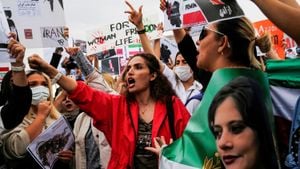Germany witnessed unprecedented voter turnout during the 2025 Bundestag elections, reaching 82.5%, marking the highest participation since the reunification of the country. This figure stands starkly above the 76.4% turnout recorded during the last election in 2021, showing not only the restoration of trust in the electoral process but also the citizens' heightened engagement with the political climate.
Political observers, including Professor Jasmin Riedl from the University of the Bundeswehr Munich, noted the surge as expected, attributing it to the emotional climate surrounding the elections. "The people are emotionally engaged. With the election outcome, there is much optimism, but also concern connected to it, regardless of party affiliation," Riedl stated. Leading up to the elections, significant issues such as migration policies had sparked fervent discussions among voters, motivating even those who previously chose to abstain from voting to make their voices heard.
Riedl pointed out the turning point came with proposals from the Union for stricter migration policies, which received support from the Alternative for Germany (AfD). This shift seemed to energize many voters, as public sentiment shifted toward viewing this election as pivotal for the nation’s future. She noted, "Some non-voters believe their voice cannot make a difference among millions. Now, many felt the need to express their position. That feeling escalated over the past weeks, creating what felt like a 'fateful election.'" This urgency pushed many citizens to the polls.
The election also showcased significant gains for key political parties. According to data from the polling institute, some 900,000 former non-voters cast their votes for the CDU or CSU, whereas the AfD saw support from approximately 1.81 million who had previously abstained from voting. Riedl highlighted the AfD's rhetorical approach, which appeals to those frustrated with the mainstream political discourse: "When a party credibly offers anti-establishment rhetoric and claims politics isn’t serving the people, it resonates with certain demographics."
While the rise of the AfD presents challenges, it reflects broader trends within voter participation. Riedl suggests the Union's success with former non-voters could partially stem from recent demonstrations against the rise of authoritarianism, indicating citizens' desire to counteract perceived threats. This has elicited gratitude from local leaders, with the Mayor of Unna, Dirk Wigant, stating, "I am very pleased with the significantly increased voter turnout. This result shows our citizens are taking responsibility and want to actively shape the future. It makes me proud to see Unna's turnout even exceeding the national average. This is a strong signal for lived democracy."
Region-wise turnout varied, with some states reporting particularly high engagement. For example, Baden-Württemberg recorded 83.4%, and Bavaria reached 84.5% participation. Conversely, areas like Bremen and Sachsen-Anhalt reported lower rates, emphasizing the diverse electoral behavior across the country. For example, Bielefeld noted 81.9%, which, though below the national average, reflected significant growth from past elections where participation was noticeably lower.
Aside from geopolitical factors, historical trends show notable fluctuations. Continuous participation has been recorded above 85% for the first decades of post-war Germany, peaking at 91.1% during the 1972 elections. Since then, the rates have fluctuated, dipping to alarmingly low figures such as 70.8% in 2009. The present surge offers hope for rekindling faith in democratic processes, countering the fears of declining public interest.
Moving forward, the political ramifications of this record turnout will be significant, influencing potential coalition formations and future legislative efforts. Political analysts are now focusing on the possible governance combinations, speculating on how the significant successes of both the CDU and AfD might reshape traditional party alliances.
Overall, this election reflects not just numbers but also the changing attitudes within German society, the urgent political conversations happening on the ground, and the collective hope for democratic rejuvenation. With over 59 million eligible voters, the impact of 82.5% participation could trigger shifts not only within party dynamics but also affect policies concerning pressing issues faced by contemporary Germany.



